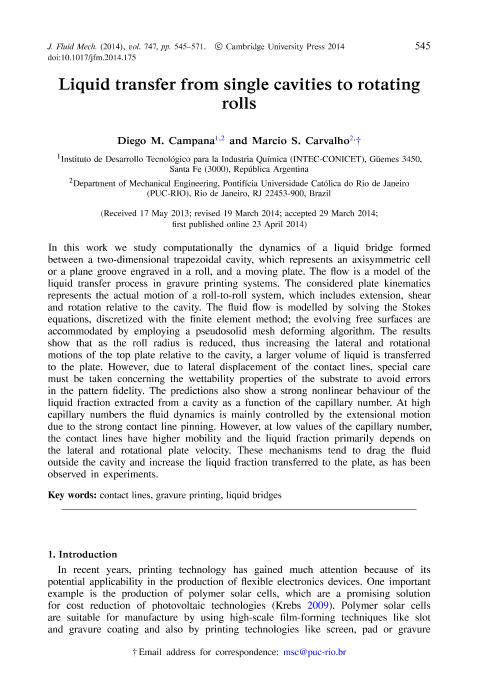Mostrar el registro sencillo del ítem
dc.contributor.author
Campana, Diego Martin

dc.contributor.author
Carvalho, Marcio
dc.date.available
2016-12-14T14:57:55Z
dc.date.issued
2014-05
dc.identifier.citation
Campana, Diego Martin; Carvalho, Marcio; Liquid transfer from single cavities to rotating rolls; Cambridge University Press; Journal Of Fluid Mechanics; 747; 5-2014; 545-571
dc.identifier.issn
0022-1120
dc.identifier.uri
http://hdl.handle.net/11336/9334
dc.description.abstract
In this work we study computationally the dynamics of a liquid bridge formed between a 2D trapezoidal cavity, which represents an axisymmetric cell or a plane groove engraved in a roll, and a moving plate. The flow is a model of the liquid transfer process in gravure printing systems. The considered plate kinematics represents the actual motion of a roll-to-roll system, which includes extension, shear and rotation relative to the cavity. The fluid flow is modeled by solving the Stokes equations, discretized with the finite element method; the evolving free surfaces are accomodated by employing a pseudo-solid mesh deforming algorithm. The results show that as the roll radius is reduced, thus increasing lateral and rotational motions of the top plate relative to the cavity, a larger volume of liquid is transferred to the plate. However, due to lateral displacement of the contact lines, special care must be taken concerning the wettability properties of the substrate to avoid errors in the pattern fidelity. The predictions also show a strong non-linear behavior of the liquid fraction extracted from a cavity as a function of the capillary number. At high capillary numbers the fluid dynamics is mainly controlled by the extensional motion due to the strong contact line pinning. On the other hand, at low values of capillary number, the contact lines have higher mobility and the liquid fraction primarily depends on lateral and rotational plate velocity. These mechanisms tend to drag the fluid outside the cavity and increase the liquid fraction transferred to the plate, as been observed in experiments.
dc.format
application/pdf
dc.language.iso
eng
dc.publisher
Cambridge University Press

dc.rights
info:eu-repo/semantics/openAccess
dc.rights.uri
https://creativecommons.org/licenses/by-nc-sa/2.5/ar/
dc.subject
Contact Lines
dc.subject
Liquid Bridges
dc.subject
Gravure Printing
dc.subject.classification
Ingeniería Mecánica

dc.subject.classification
Ingeniería Mecánica

dc.subject.classification
INGENIERÍAS Y TECNOLOGÍAS

dc.title
Liquid transfer from single cavities to rotating rolls
dc.type
info:eu-repo/semantics/article
dc.type
info:ar-repo/semantics/artículo
dc.type
info:eu-repo/semantics/publishedVersion
dc.date.updated
2016-12-12T13:43:32Z
dc.journal.volume
747
dc.journal.pagination
545-571
dc.journal.pais
Reino Unido

dc.journal.ciudad
Cambridge
dc.description.fil
Fil: Campana, Diego Martin. Consejo Nacional de Investigaciones Científicas y Técnicas. Centro Científico Tecnológico Santa Fe. Instituto de Desarrollo Tecnológico Para la Industria Química (i); Argentina
dc.description.fil
Fil: Carvalho, Marcio. Pontificia Universidad Catolica Do Rio de Janeiro; Brasil
dc.journal.title
Journal Of Fluid Mechanics

dc.relation.alternativeid
info:eu-repo/semantics/altIdentifier/doi/http://dx.doi.org/10.1017/jfm.2014.175
Archivos asociados
